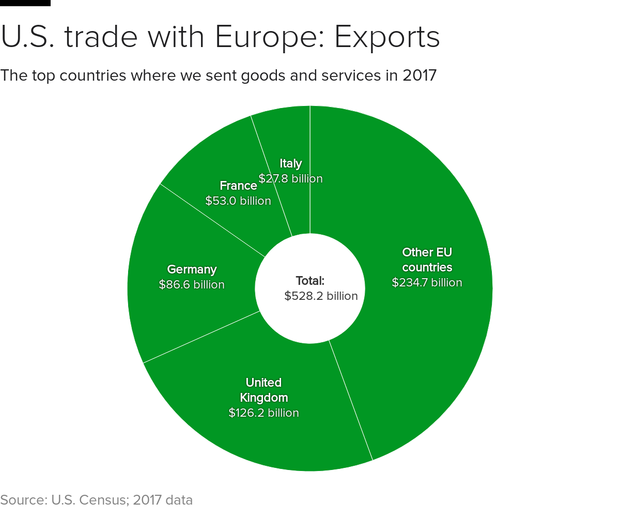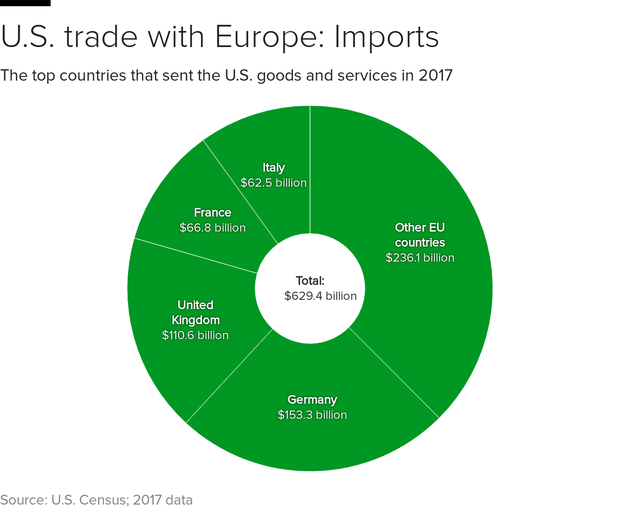President Trump stunned a global audience when he named the European Union as a trade “foe” in an interview with CBS News on Sunday. Here are some things to know about the EU-U.S. trade relationship:
Europe and the U.S. are each other’s most important market
The trading partners generate $5.5 trillion in total commercial annual sales, according to a recent report from the American Chamber of Commerce to the European Union and researchers at Johns Hopkins University. The relationship accounts for as many as 15 million workers in mutually “on-shored” jobs on both sides of the Atlantic, the report said.
“It is the largest and wealthiest market in the world, accounting for one-third of world GDP in terms of purchasing power and half of total global personal consumption,” according to the report.
Ambassadors from the EU reinforced that notion in an opinion piece in the Washington Post last month, which also mentioned the depth of the trade relationship.
U.S. goods and services direct trade with the EU totaled nearly $1.1 trillion in 2016, according to the U.S. Trade Representative. Exports totaled $501 billion, while imports totaled $592 billion. The U.S. goods and services trade deficit with the EU was $92 billion in 2016. The deficit for goods alone was larger: $147 billion in that year, according to the USTR.

Mr. Trump focuses on trade deficits
But economists say the relationship is far more complicated — and beneficial.
The U.S. economy is consumer-based, with households saving far less than their counterparts in Europe. The personal savings rate among Americans is about 3.2 percent, according to the St. Louis Fed. In Europe, it’s more than 10 percent, according to Tradingeconomics.com and Eurostat.
So during economic boom times like now, consumers are more likely to spend more than they save, and that includes buying imported goods and services. When the economy slumps, consumers spend less, and trade deficits decline, like during the Great Recession a decade ago.
That also means tariffs aren’t necessarily the best way to alter a relationship with another trading entity, most economists say. On the contrary, free trade agreements have prompted European companies to set up manufacturing plants in the U.S., resulting in U.S. jobs.

Mr. Trump’s trade policies affect jobs for both sides
Take autos. The president’s proposed 20 percent tariff on EU auto imports may cost 100,000 U.S. jobs in 2019 alone, economists at Oxford Economics estimated in a June 28 note.
Because the tariffs would inject “uncertainty” into the U.S. economy, the “total shock” could be twice as large, the analysts wrote. It would also be felt quickly. Mostly luxury auto brands would be hit, such as Audi, BMW and Mercedes, “but higher import prices for parts could affect the pricing of mid-range vehicles produced in the U.S. like Volkswagen,” the analysts wrote.
German brands employ more than 36,500 U.S. workers
And they’re mostly in the South. BMW’s Spartanburg, South Carolina, plant alone produced more than 371,000 BMW X3, X4, X5 and X6 models in 2017 and employs more than 10,000 people, according to the company.
“So we’re buying more of all goods, some of which are going to be from Europe. We have this predisposition for German cars, whether it be a high-level Mercedes or typical Volkswagen. The popularity of German cars is quite high,” said Michelle Casario, an assistant professor of economics at Villanova University.
“What’s not talked about is that the major producers have factories in the U.S. BMW and Mercedes have massive factories in the U.S. that employ thousands of American workers,” Casario said. “Many of these companies have plans to expand and hire more workers in high-paying jobs. And a trade war and retaliatory tariffs are going to hurt that relationship, and end up costing jobs. So while we can look at the trade deficit as one measure of our relationship to Europe, it’s so much bigger than that.”
Tariffs on both sides are traditionally low
The average weighted tariffs for U.S. exports to the EU in 2017 were 1.4 percent. Only Japan was lower at 0.6 percent, according to a recent note from Oxford Economics using World Trade Organization and its own calculations.
Tariffs on exports into the U.S. from the EU (or U.S. imports from the EU) were 1.6 percent, above Canada at 1.3 percent and just below Japan at 1.8 percent.
Tariffs are a tax on consumers who buy imported goods
U.S. companies may also raise prices of goods, like autos, that compete with the imports, economists like Casario point out. That happened when the Trump administration imposed tariffs on Korean washing machines earlier this year, The Wall Street Journal noted this week.
Harley-Davidson (HOG) is moving some production to Europe, at the cost of U.S. jobs, because of the EU’s retaliatory tariffs for Mr. Trump’s on steel and aluminum made it too expensive for the company to export them to Europe.

Swedish carmaker Volvo, which opened a factory in South Carolina earlier this year, expects to employ 2,000 people initially, eventually bringing the workforce up to 4,000, according to its website. “If you have trade barriers and restrictions, we cannot create as many jobs as we are planning to,” Volvo Cars CEO Hakan Samuelsson told Reuters at an event celebrating the new facility last month.
Mr. Trump’s trade policies may crimp EU growth
In June, the International Monetary Fund cut its growth forecast for the EU to 2.2 percent this year, down 0.2 percentage points from its April outlook. The IMF also said trade frictions may imperil world growth as a whole, according to Bloomberg.
The EU just signed its own trade deal with Japan
The new Japan-EU agreement eliminates about 99 percent of the tariffs on Japanese goods sold to the EU. About 94 percent of the tariffs on European exports to Japan will be lifted, rising to 99 percent in the future. The difference reflects exceptions on such products as rice, which enjoys strong political protection from imports in Japan.
This agreement makes it more attractive for the trading partners to sell to each other, just as the U.S. is slapping restrictions on most of its own global trading partners. Combined, the EU and Japan make up for about a third of the global economy, touching more than 600 million people.
“The EU and Japan showed an undeterred determination to lead the world as flag-bearers for free trade,” Japanese Prime Minister Shinzo Abe said at a joint news conference with European Council President Donald Tusk and European Commission President Jean-Claude Juncker. Tusk said the pair are “sending a clear message” against protectionism.
The EU is also looking beyond Japan. On Monday, Juncker and Tusk were hosted by Chinese Premier Li Keqiang, who emphasized upholding free trade and multilateralism, just as the Trump administration considers more tariffs and shows no signs of negotiation, Reuters reported.
The U.S. is appealing the retaliatory tariffs at the WTO
On Monday, the U.S. challenged retaliatory tariffs at the World Trade Organization, according to the U.S. Trade Representative.
The retaliations are responses to Mr. Trump’s steel and aluminum tariffs placed on allies including the EU, Mexico and Canada. China is also among those that retaliated, and it’s preparing more countermeasures in case Mr. Trump moves to impose $200 billion more, as he is threatening.
– The Associated Press contributed to this report.
